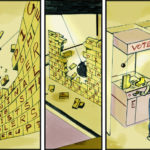By Gil Asakawa, NikkeiView
March 22, 2004 – Ah, springtime. The temperatures are warmer, the birds are louder, the dawn breaks earlier, and flowers begin to peek out from the ground and buds poke from branches.
Spring is special for the Japanese. April is when the new school year begins in Japan; it’s also the beginning of the new fiscal year. And most notably, this time of year throughout Japan, people anticipate the arrival of springtime with the blooming of the sakura, or cherry blossoms. Not only is “Sakura, Sakura” one of the best-known folk songs of Japan, the sakura is the national flower of Japan, with over 400 varieties that do not yield fruit, just the fragile flowers, and it’s a centuries-old national pastime to mark the flowering of the trees every spring throughout the country.
There’s even a word for it, hanami, which means “the viewing of flowers,” where families plan picnics beneath soft white and pink canopies in neighborhood parks, and marvel at the beauty around them. Lovers wine and dine among the fallen blossoms and sing of the brevity and joy of life.
In a dark twist, this brevity – and the grace with which the dying blossoms fall to the earth — was used as a nationalistic hook to recruit the kamikaze suicide bombers during World War II. But these days, the loveliness of the blossoms evoke warmth and peace for all Japanese.
It’s such an important national obsession that the weather reports in March even begin predicting the peak viewing days for the cherry blossoms. The forecasters diligently follow the “sakura front” as the warm weather brings the blossoms northward.
The trees are grown all over Japan, and some cities are especially well-known for their blossoms, including Kyoto and Tokyo. One of the best-known places in Tokyo for hanami is Ueno Park, which I know I visited when I was a kid in Japan, but I don’t remember if we went there to view the cherry blossoms, because there’s also a famous zoo at the park.
For Greenthumbs @ Amazon
|
I do remember that when we moved to the U.S. and lived in northern Virginia for a few years, we would drive every spring to the area around the Jefferson Memorial in Washington, D.C. to admire the cherry blossoms that were given as a gift from the city of Tokyo to Washington. I was always amazed at how silky-soft the petals of the cherry blossoms were.
In Washington, D.C., the annual Cherry Blossom Festival celebrates its 92nd year this year between March 27-April 11, with a parade and lots of cultural activities planned throughout. The National Parks Service, like the Japanese media, has predicted the peak pretty point for this spring between March 26 and April 4.
The cherry blossoms were first planted in Washington, D.C. in 1912, when 3,000 trees were sent by Tokyo Mayor Yukio Ozaki. (An earlier gift of cherry blossoms was destroyed because they were diseased.) In return, the U.S. government sent a gift of dogwood trees (Virginia’s state tree) to Japan in 1915. In 1965, another 3,800 trees were sent from Japan and planted around the banks of the Potomac. The U.S. returned the favor in 1981 when Japanese horticulturalists took cuttings of Yoshino cherry trees in D.C. to take back to Japan to replace trees that had been destroyed in a flood.
When we lived in Virginia, my dad also planted a cherry blossom tree smack dab in the middle of our front yard. It was a scrawny sapling at first, but a sturdy little tree when we moved away in the early 1970s. Now, it’s a huge, beautiful tree that blooms every year for the lucky current owners. I hope they appreciate its importance. I always took the tree for granted because I had grown up seeing them all over Japan, and we could see them in Washington D.C.
But here in Colorado, where the climate and soil are less hospitable to the cherry tree, I miss them. We have some cherry trees planted along Speer Boulevard near downtown Denver, but they’re nowhere near the seasonal majesty of other places.
For the record, Denver’s Sakura Matsuri isn’t hooked to the blooming of cherry blossoms, partly because of the unpredictable spring weather and partly because of the encroaching schedule of the Colorado Rockies baseball team, whose stadium is a block from Sakura Square, Denver’s “tiny Tokyo.” Sakura Matsuri in Denver is a summertime affair.
Even with the festival every year in Washington and the dozens of Cherry Blossom Festivals, or Sakura Matsuri, held around the country, it’s hard to imagine the same level of reverence for a flower or tree in the United States as there is for sakura in Japan. The closest I can think of is here in Colorado, where the aspen is appreciated for its glittery golden foliage every October, shimmering like gold flakes tossed along the Rocky Mountains.
Most Americans just seem to be less attuned to nature than the Japanese. And I don’t mean all Americans should be “tree huggers” or nature freaks. The average everyday Japanese simply has more of an awareness of and appreciation for all the beauty and depth of the natural world. It’s part of their fundamental spirituality, with Shintoism attributing godlike spirits to everything from rocks and water to the trees and sky, and Buddhism treating nature with holy reverence.
Then again, even modern Japan has sadly become more “Westernized” and is chockfull of disposable- and instant-culture. But the enduring popularity of hanami as part of the country’s calendar shows there’s still a reverence for nature that’s rare here.
Maybe it’s time to pay closer attention to the changing of the seasons, and picnic amongst our blooming trees and shrubs this weekend.
You can read about the National Cherry Blossom Festival here.
|
|
|---|
|
Gil Asakawa is author of the book, Being Japanese American (Stone Bridge Press June 2004). He has 20 years of experience covering popular culture and the arts, as a music critic, feature writer and editor of a weekly arts and entertainment magazine. He has served as Content Editor for Digital City Denver, TRIP.com, and ServiceMagic.com, and Denver’s TamTam.com. His writing has appeared in Denver Rocky Mountain News, Rolling Stone, Pulse, and Creem, among many others, and he is co-author of The Toy Book, a history of baby-boom era toys (Knopf 1991). A comprehensive archive of his art and writings awaits you at Nikkeiview.com. IMDiversity.com is committed to presenting diverse points of view. However, the viewpoint expressed in this article is the opinion of the author and is not necessarily the viewpoint of the owners or employees at IMD. |













